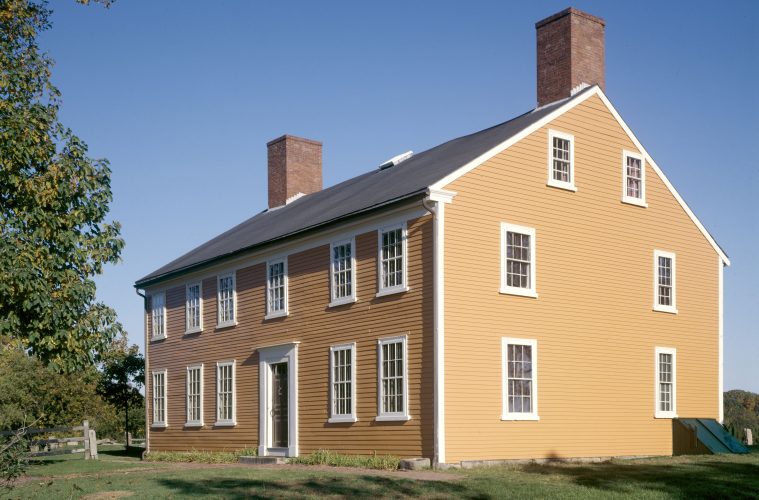The North Shore is studded with historic gems that are often found in the most out of the way locations. A wrong turn off a main street in Marblehead or Gloucester can yield an unexpected discovery that reveals just how much the past bubbles up to the surface here. A perfect example of this phenomenon is Cogswell’s Grant in Essex. One of Historic New England’s many sites, this house sits at the end of a residential road a short way away from the Essex Cultural District and the eternally popular Woodman’s restaurant, a piece of colonial history catching the unsuspecting driver almost unawares.
Cogswell’s Grant, named after the land grant given to John Cogswell in 1636, is now a museum. The Cogswell family lived on the property until 1839 and the original grant of 300 acres was divided between John’s descendants, one of whom built the 1728 house that serves as the museum. Unlike most historic houses scattered throughout the area, the building and accompanying barn are not the main attraction, but a picturesque addition to the real focal point. People flock to this spot for what resides inside the house—the intact folk art collection of Nina Fletcher Little and Bertram Kimball Little, renowned collectors who used this property as their summer home from 1937 to their deaths in 1993. After their deaths, the Littles’ left their collection to Historic New England, which opened it to the public in 1998.
The museum is one of the only places where viewers can see a complete collection of this type in the house that it was curated for. Every room is filled with antiques dating from the 1700 and 1800’s whose origins were tirelessly researched by Nina Fletcher Little and documented in one of her many books on collecting the so-called Country Arts. These items range from portraits to pottery to pots and pans. Decorative boxes of all sizes and hues litter every surface and hand-hooked rugs adorn the floors in this two-story structure. Because of the age and fragility of both the artifacts and the house itself, visitors must wear blue hospital booties over their footwear and are instructed not to touch to protect the exhibits. Despite these precautions, the house setting still grants a relatively up close and personal view of antiques that would otherwise be sheltered behind sheets of glass in another museum.
What is most remarkable about these artifacts is the class of people they were originally constructed for. In a time when almost all collectors were focused on grabbing up masterworks made for the elite upper classes, the Littles’ passion was for the “country” class of artifacts, those everyday items used by ordinary people and made, not by famous artisans, but by local painters and potters and weavers whose wares furnished the houses of their neighbors. For instance, the Littles’ ceramic collection consists mostly of red ware pottery, a variety made in America for everyday use.
The Littles’ were also interested in the local history of the area, both having come from families with colonial ties. Bertram Kimball Little’s ancestors were Salem shipping merchants, a legacy reflected in the Swampscott neighborhood Little’s Point, and Nina Fletcher Little came from textile manufacturers in Rhode Island. Both inherited items used by their ancestors handed down through the generations, sparking in them a desire to gather more of the past about them. This desire for local history is reflected most in the people whose portraits they purchased. Most of these paintings are depictions of past inhabitants of Gloucester and Ipswich and other towns nearby. Some of their descendants still live in the area and visit the museum on occasion.
Also a part of the collection is a landscape of Derby Farm by Ezekiel Hersey that shows modern day Salem’s Lafayette Street in its pastoral beginnings and features an image of a building that still stands along the thoroughfare today.
Along with being a fabulous and informative museum, the grounds also feature a working farm, one of the oldest continuously in use farms in the area. Caretakers harvest wheat that grows in the picturesque 164 acres of land that the house sits on.
Tours of the collection are offered every hour on the hour from 10 till 4 Wednesdays to Sundays and are lead by expert tour guides equipped with handy notecards filled with information on each piece in the collection, so no question is likely to go unanswered. When your visit has finished, make sure to check out one of the excellent antique stores in Essex to pick up a piece of history and perhaps start your very own collection.
Tickets: $10 Adult, $9 Senior, $5 Student, Free for Historic New England member and Essex Residents.
10 a.m.-4 p.m. Wednesday to Sunday June 1-October 15.
Free Parking. 60 Spring Street, Essex. 978-768-3632.
For more information, visit Historicnewengland.org/historic-properties/homes/cogswells-grant

